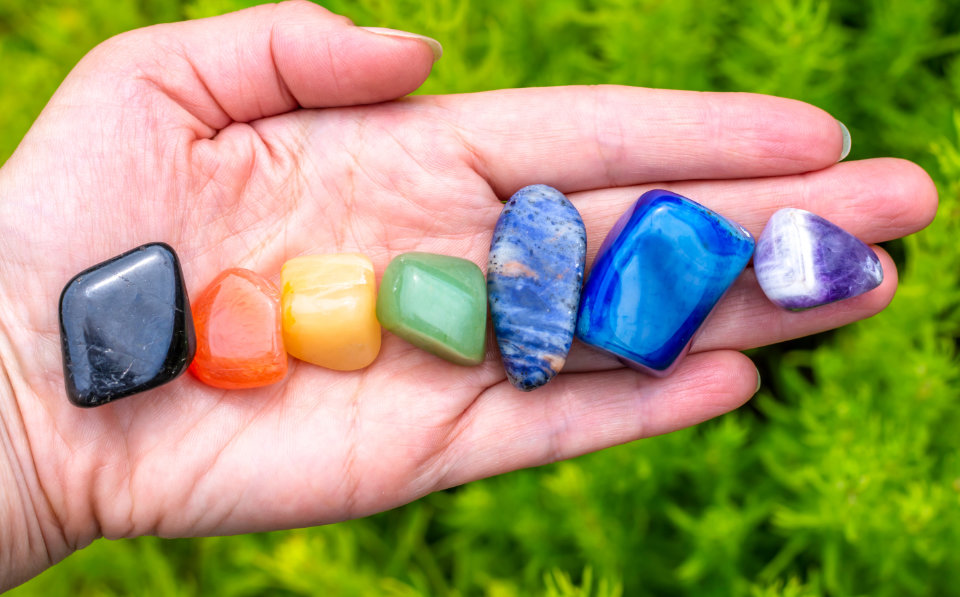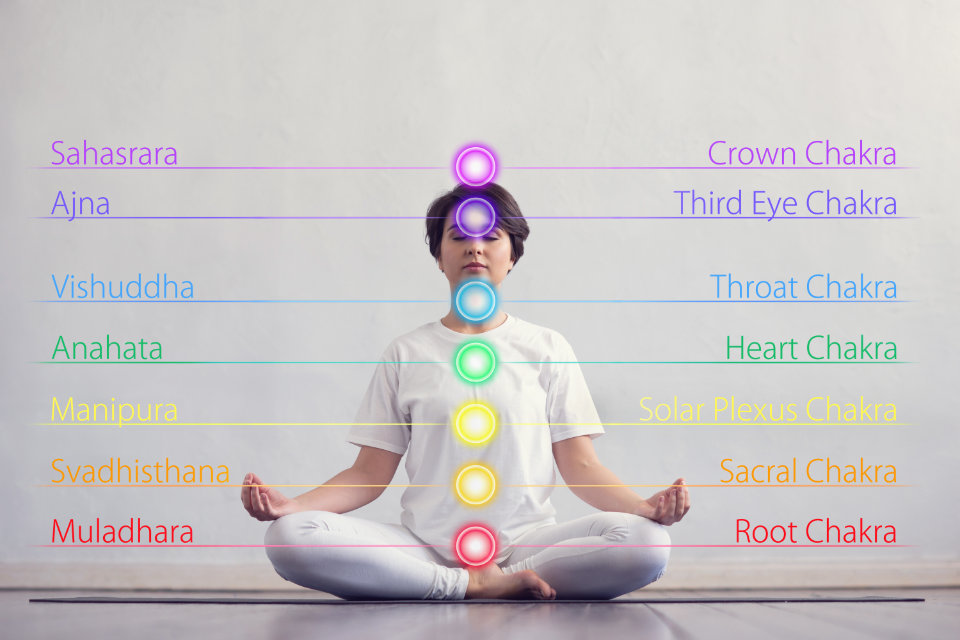In the pursuit of inner harmony and energy alignment, the meaning behind chakra stones becomes profoundly significant.
These vibrant stones are intimately linked with the body’s chakra system, each resonating with specific frequencies that aid in balancing and revitalizing our energy centers.
Understanding Chakras: Origins and Insights
The concept of chakras originates from ancient Indian philosophy and is a critical element of Ayurveda and yoga traditions. The term ‘chakra’ translates to ‘wheel’ or ‘disk’ in Sanskrit, which is emblematic of the idea that chakras are spinning wheels of energy within the body.
According to this philosophy, there are seven main chakras that align along the spine, starting from the base and moving up to the crown of the head. Each chakra corresponds to different bodily functions, emotions, and spiritual dimensions.
The history of chakras dates back to the earliest Vedic texts, which are among the oldest writings in Sanskrit and the foundation of Hinduism.
These chakras were understood not just as physical entities but as intersections of the physical and spiritual, with each one associated with specific mantras, colors, and symbols that reflect their essence and function.
This system has been integral to various healing and spiritual practices for millennia, providing a framework for understanding the connection between our physical and energetic bodies.
The Power of Chakra Stones: Symbolism and Significance
Chakra stones, also referred to as healing crystals, are believed to have specific frequencies and properties that resonate with the vibrations of the chakras.
This belief is rooted in the ancient practice of crystal healing, which dates back to at least 6,000 years ago to the time of the ancient Sumerians of Mesopotamia. Ancient Egyptians were also noted for their use of crystals both in healing and to guide the dead into the afterlife.
The power attributed to chakra stones stems from their historical use as a means to influence the subtle energies of the body. Cultures from around the world have used various stones and crystals for meditative, therapeutic, and spiritual practices.
For example, lapis lazuli has been prized for its deep blue hue and was used by the Egyptians for spiritual enlightenment and as a symbol of truth.
In contemporary practice, each stone is aligned with a chakra based on its color and energetic properties. It is believed that by placing these stones on or near the body’s chakra points, or by simply holding or wearing the stones, one can promote the free flow of energy throughout the body.
This harmonization of energy is thought to assist in healing physical, emotional, and spiritual imbalances, leading to greater wellness and equilibrium.
The use of chakra stones is not just a physical healing practice but also an acknowledgment of the profound interconnectedness of our physical and spiritual selves.
As tools for energy modulation, chakra stones serve as a means to access and influence our deepest energetic layers, helping to unlock and sustain a more potent and harmonious state of being.

In-Depth Meanings and Applications of Chakra Stones
Chakra stones are not only distinguished by their colors, which correspond to their respective chakras, but also by the unique energetic properties they are believed to possess.
Here’s a more detailed exploration of each:
1. Root Chakra Stones (Muladhara):
- Color: Typically red or black.
- Area of Use: The base of the spine, tailbone area.
- Stones: Red Jasper, Black Tourmaline, Smoky Quartz.
- Best For: Those seeking stability, grounding, and physical energy.
- Caution: Not recommended for those who are already very grounded or who may have a sluggish energy flow, as it could exacerbate a sense of lethargy.
2. Sacral Chakra Stones (Svadhishthana):
- Color: Orange.
- Area of Use: Lower abdomen, about two inches below the navel.
- Stones: Carnelian, Orange Calcite, Tiger’s Eye.
- Best For: Individuals looking to enhance creativity, sexual vitality, and emotional expression.
- Caution: May be overwhelming for those with already heightened emotions or those dealing with emotional trauma, potentially causing overstimulation.
3. Solar Plexus Chakra Stones (Manipura):
- Color: Yellow.
- Area of Use: Upper abdomen, stomach area.
- Stones: Citrine, Yellow Jasper, Golden Topaz.
- Best For: Those in pursuit of confidence, personal power, and the ability to manifest desires.
- Caution: People prone to anxiety or stress should use these stones sparingly as they can amplify energy, which may increase feelings of unrest.
4. Heart Chakra Stones (Anahata):
- Color: Green or pink.
- Area of Use: Center of the chest, just above the heart.
- Stones: Rose Quartz, Green Aventurine, Jade.
- Best For: Individuals looking for love (self-love and relationships), compassion, and emotional balance.
- Caution: Those who are dealing with grief or heartbreak should approach these stones gently, as they can release pent-up emotions.
5. Throat Chakra Stones (Vishuddha):
- Color: Blue.
- Area of Use: Throat.
- Stones: Blue Lace Agate, Aquamarine, Turquoise.
- Best For: People seeking to improve communication skills, express themselves truthfully, and enhance creativity.
- Caution: Can lead to excessive talking or over-sharing if not used mindfully.
6. Third Eye Chakra Stones (Ajna):
- Color: Indigo or dark blue.
- Area of Use: Forehead, between the eyes (also called the brow chakra).
- Stones: Amethyst, Lapis Lazuli, Indigo Sapphire.
- Best For: Those wishing to deepen intuition, enhance psychic abilities, and expand imagination.
- Caution: Overuse can result in becoming ungrounded or disconnected from reality.
7. Crown Chakra Stones (Sahasrara):
- Color: Violet or clear/white.
- Area of Use: Very top of the head.
- Stones: Clear Quartz, Selenite, Amethyst.
- Best For: Individuals seeking spiritual connection, enlightenment, and a sense of oneness with the universe.
- Caution: May cause spaciness or a disconnection from the earthly matters if not balanced with grounding practices.
Each chakra stone serves a specific purpose and can be used for targeted chakra healing and balancing. The selection of a chakra stone should align with the user’s current energetic needs and intentions.
For example, a person seeking to overcome fears may turn to Root Chakra stones for stability, while another needing to foster forgiveness might gravitate towards Heart Chakra stones.
It is also important to note that the stones are not a one-size-fits-all solution. Sensitivities vary, and what is powerful and effective for one person may be too intense for another.
Similarly, while some may need the energizing influence of a Solar Plexus Chakra stone like Citrine, others may find it disrupts their sleep or exacerbates nervous energy.
Therefore, mindfulness in use, personal intuition, and possibly guidance from a knowledgeable practitioner are key to the effective use of chakra stones.

How to Use Chakra Stones Effectively
Using chakra stones can be a deeply personal and enriching practice. Here’s a step-by-step guide to integrating these powerful tools into your routine:
- Cleanse Your Stones: Before use, cleanse each stone to remove any previous energy and prepare them for your intentions. This can be done with smudging (using sage or palo santo), running them under natural water, or leaving them out in moonlight.
- Set Your Intentions: Hold each stone in your hands and focus on the intention or healing you desire from it. This could be anything from emotional healing to physical health or spiritual awakening.
- Meditation Incorporation:
- Begin by finding a quiet space where you won’t be disturbed.
- Sit or lie down comfortably and take a few deep breaths to center yourself.
- Place each stone on its corresponding chakra point or hold them in your hands.
- Visualize each chakra opening and the stone’s energy flowing into and through it.
- Continue to meditate for as long as feels right for you, ideally between 10 to 30 minutes.
- Yoga and Stones: Place stones on your yoga mat or nearby when practicing. Certain poses correspond with chakra locations and can be enhanced with the presence of the relevant stone.
- Daily Carry: Carry a chakra stone with you throughout the day as a touchstone or wear as jewelry to continuously align with its energy.
- Charging Stones: Regularly charge your stones to maintain their vibrancy. This can be done by placing them in sunlight, burying them in the earth overnight, or using a charging crystal like selenite.
- Regular Cleansing: Remember to cleanse your stones after heavy use or at least once a month to keep their energies pure and powerful.
Choosing Your Chakra Stones
When selecting chakra stones, it’s important to connect with the stones that will best support your energy centers. Follow these steps to choose the right stones for you:
- Research: Start by researching the properties of various chakra stones to understand their corresponding chakras and benefits.
- Intuition: Trust your instincts. You may be naturally drawn to the color or feel of certain stones—this is your intuition guiding you to what you need.
- Physical Interaction: If possible, physically interact with the stones. Hold them in your hand and notice which ones feel particularly resonant or produce a sensation of warmth, pulsing, or energy.
- Personal Relevance: Consider any personal challenges, goals, or areas of life you are looking to improve. Select stones that are known to assist in these areas.
- Expert Consultation: Don’t hesitate to ask for guidance from an expert in crystal healing or chakras. They can offer valuable insight into the most suitable stones for your needs.
- Quality over Quantity: It’s better to have a few stones that you connect with deeply than many that don’t resonate with you. Choose quality stones that you feel a strong attachment to.
- Diverse Selection: Having a range of stones for different chakras can be beneficial, as it allows you to work on multiple areas of your life.
By mindfully selecting and using chakra stones, you can create a powerful personal practice that supports your physical, emotional, and spiritual well-being.
Chakra Stones in Everyday Life
Integrating chakra stones into your daily routine can help maintain a flow of positive energy and balance throughout the day.
Here’s how you can make chakra stones a part of your life:
- Wear as Jewelry: Many people wear chakra stones as jewelry. For example, a necklace with a pendant that lies close to the heart chakra or bracelets that allow stones to touch the skin at the pulse points. The constant contact with the skin is believed to transfer the stone’s energy directly to the wearer.
- Carry Them: Carrying a chakra stone in your pocket or purse allows you to touch and hold the stone whenever you feel the need for its specific energy or support.
- Home and Workspaces: Placing chakra stones in your living or workspace can create an environment of balanced energy. Stones can be placed in specific areas to enhance the flow of energy, such as a clear quartz near a computer to combat electromagnetic energy or a rose quartz in a bedroom to promote peaceful relationships.
- Chakra Stone Grids: Creating a grid of chakra stones in a meditation space can amplify the energies and intention of your healing work.
- Sleeping with Stones: Placing chakra stones under your pillow or on a bedside table can contribute to a restful sleep and encourage subconscious healing.
- Bathing with Stones: Some stones can be placed in bath water for a soothing and energetically charged soak. Ensure the stones you choose are not water-soluble or toxic.
In every instance, the proximity and placement of these stones are intended to align subtly with your energy field, contributing to an overall sense of well-being.
Common Misconceptions About Chakra Stones
Chakra stones are a part of a holistic approach to wellness, but there are common misconceptions that can lead to overreliance on them:
- Cure-All Misconception: Some may believe chakra stones are a cure-all for any ailment. It’s important to understand that they are a complementary therapy, meant to be used in conjunction with traditional medicine and not as a replacement.
- Instant Fix Misconception: The idea that chakra stones provide immediate solutions is another misconception. Healing with stones is a process that requires time, intention, and often, other supportive actions.
- Power Misconception: Some people expect the stones to work without their input. The power of chakra stones is activated by the belief and intention of the user; they are not inherently magical or powerful without the user’s engagement.
- One-Size-Fits-All Misconception: Not every chakra stone is suited for every person. Individual energy systems are unique, and what works for one may not work for another.
- Substitution for Professional Help Misconception: Relying solely on chakra stones for serious physical or psychological issues can be harmful. Professional medical or psychological assistance should always be sought when needed.
Understanding the role of chakra stones in energy work helps to utilize their benefits effectively while maintaining realistic expectations and a balanced approach to health and well-being.
Embracing the Vibrant Journey with Chakra Stone
The journey into understanding chakra stones and their meanings is a captivating exploration of the interplay between our physical form and spiritual essence, much like the principles of Feng Shui that harmonize individuals with their surrounding environment.
By selecting and utilizing these potent symbols of the Earth’s energy, aligned with Feng Shui practices, we can facilitate a deeper connection with our chakra system, enhancing our overall well-being.
Whether used in meditation, worn as jewelry, or strategically placed in our living spaces in accordance with Feng Shui, chakra stones offer a tangible touchpoint to the subtle energies that animate our lives.
Embrace the unique vibrations and meanings of these stones to unlock your potential and journey towards a more balanced and harmonious state of being.



